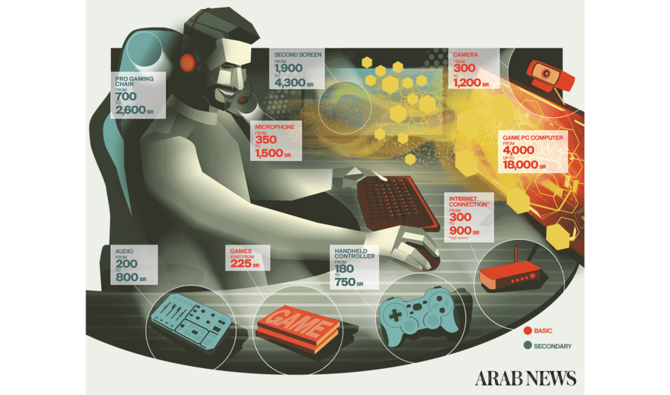RIYADH: Thousands of people worldwide watch livestream gaming videos, and now game streamers have become more popular than ever, but there is more to this than meets the eye.
The dawn of the age of the streamer has arrived, and in the internet era where content is king, few creators are as enviable as those whose jobs are to get paid to play games.
But to spend money, one has to make money, and in the world of streaming, that particular adage rings truer than most.
As video gaming and e-sports continue to boom in popularity across the region, Arab News spoke to Arab streamers about how they got to where they are, and the price they paid for their success.
Omani streamer Ahmed Al-Maimani, a Twitch partner and YouTuber known as Pistyization (or Pisty for short), started streaming 5 years ago as a way to generate a side income while trying to obtain his master’s degree as an international student living in Bristol.
“I didn’t make much money out of it at first; I was actually losing money, but I didn’t care and I fell in love with it anyway,” he said.
When you’re starting out, good charisma is far more important than professional equipment.
Ahmed Al-Maimani, Omani streamer
Al-Maimani ended up quitting his day job to pursue streaming fulltime, and has since grown his platform and fanbase significantly, with over 300,000 followers on YouTube and past collaborations with companies such as Activision, Ubisoft, Asus and Logitech.

For Saudi streamer Jemeel Alturkustani, who goes by the moniker Jemimaru, online streaming began as a hobby around 8 years ago.
“I started streaming to have company, interact, have fun and make new friends. It’s almost like having your friends over to play video games and hang out with,” he said.
But as his interest in streaming grew, so did the size of his bills. “Over the course of 8 years, I’ve probably invested well over $10,000 or $15,000, cycling through console generations, a few PCs and other equipment. But it’s hard to estimate yearly spending since it depends on what’s being released that year,” he said.
For Al-Maimani, who streams fulltime as opposed to Alturkustani’s part time, the costs are significantly higher, though he does get by with a little help from sponsors.
“I would’ve spent more than $10,000 a year on games and equipment, but my background in PR has helped me get some of my stuff for free,” said Al-Maimani.
“I don’t think I’ve paid for a game since 2016 or 2017. When it comes to equipment, if I really want something I’ll buy it myself. But collectively, I’d say I’ve spent over $15,000 on my streaming so far.”
Typically, a streamer’s setup involves a PC or gaming console on which to run and play the games, the respective keyboard and mouse or controller, and a steady, fast internet connection.
A camera and microphone are arguably optional, though the most well-known and popular streamers are the ones who can be seen playing the game, reacting to the story and gameplay, and engaging with viewers via the streaming platforms’ chat functions.
Additional equipment can be seen in the form of a padded gaming chair, designed to offer comfort and support for those gaming for long stretches of time; upgraded equipment such as a controller for PC gamers; a higher-quality microphone and camera; and what Al-Maimani calls “eye candy” in the form of advanced lighting setups and gaming merchandise, prominently displayed to indicate the level of the streamer’s seriousness to viewers.
For Alturkustani, the price of being a streamer depends on one’s level of commitment. “I think streaming is fairly cheap as a hobby since gamers already own a console or PC, and most consoles now have built-in streaming support. You can start streaming with a push of a button for free,” he said.
But both Alturkustani and Al-Maimani believe that professional streamers require more than just the basic equipment in order to truly make it big.
“One of the most important things you need is a good mic. You can get away with many things but if your audio is bad, with sounds popping, it’s an instant click away for me,” said Alturkustani.

“You also need a webcam, and a secondary monitor to see the chat, and stats. Moreover, a good lighting setup, an audio mixer, and a stream deck for shortcut buttons are all huge pluses.”
For Al-Maimani, a streamer’s equipment is secondary to their knack for keeping audiences engaged, and their ability to interact with fans during a stream.
“You can have a laptop camera and microphone and still be one of the best streamers in the region,” he said.
“When you’re starting out, good charisma is far more important than professional equipment. Knowing how to talk to your audience, to pay attention to the chat without the quality of your gaming slipping, and having good judgment are bigger draws than just fancy equipment.”
You can get away with many things but if your audio is bad, it’s an instant click away for me.
Jemeel Alturkustani, Saudi streamer
But he concedes that the power of eye candy is a large part of the draw for potential new subscribers, which is why he feels he can justify the cost of his expensive “extras.”
He said: “Most of the money I make from my streaming, I spend on my streaming. The better your stream looks, the more people think you deserve their support. And more companies will want to collaborate with you when they think you look professional.”
Alturkustani agrees with him on that point. “The more you invest in improvements, the more attractive your channel becomes for the viewers,” he said.
But in hindsight, Al-Maimani said he would caution those who are looking to get into streaming purely as a means to make money, as major success stories in this industry are few and far between.
“Most people who start streaming purely to make money out of it rarely succeed. If you see other streamers getting donations and sponsorships, it’s because they worked very hard for a long time to get where they are, and it didn’t happen overnight,” he added.






















